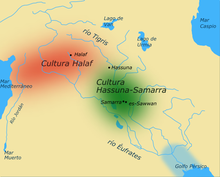Samarra culture
 | |
| Geographical range | Mesopotamia |
|---|---|
| Period | Neolithic |
| Dates | circa 5500–4800 BCE |
| Type site | Samarra |
| Major sites | Tell Shemshara, Tell es-Sawwan |
| Preceded by | Pre-Pottery Neolithic B, Halaf culture, Hassuna culture, Halaf-Ubaid Transitional period |
| Followed by | Ubaid period |

The Samarra culture is a Chalcolithic archaeological culture in northern Mesopotamia that is roughly dated to 5500–4800 BCE. It partially overlaps with Hassuna and early Ubaid. Samarran material culture was first recognized during excavations by German Archaeologist Ernst Herzfeld at the site of Samarra. Other sites where Samarran material has been found include Tell Shemshara, Tell es-Sawwan and Yarim Tepe.[1]
At Tell es-Sawwan, evidence of irrigation—including flax—establishes the presence of a prosperous settled culture with a highly organized social structure. The culture is primarily known for its finely made pottery decorated with stylized animals, including birds, and geometric designs on dark backgrounds. This widely exported type of pottery, one of the first widespread, relatively uniform pottery styles in the Ancient Near East, was first recognized at Samarra. The Samarran Culture was the precursor to the Mesopotamian culture of the Ubaid period.


